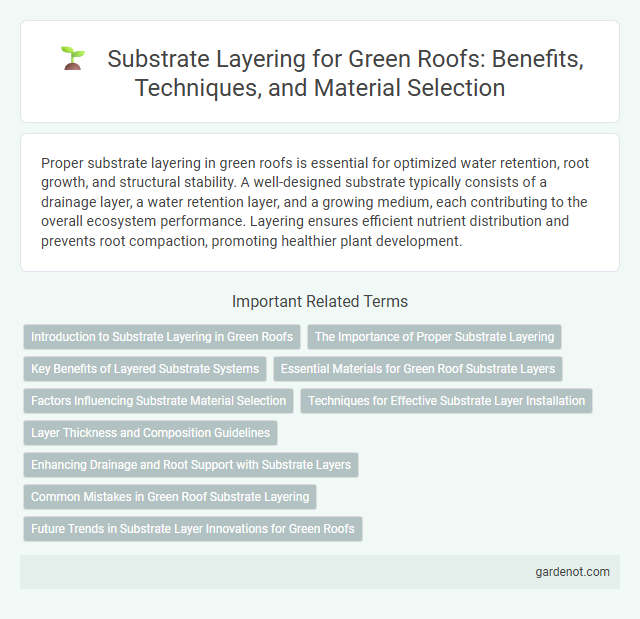Proper substrate layering in green roofs is essential for optimized water retention, root growth, and structural stability. A well-designed substrate typically consists of a drainage layer, a water retention layer, and a growing medium, each contributing to the overall ecosystem performance. Layering ensures efficient nutrient distribution and prevents root compaction, promoting healthier plant development.
Introduction to Substrate Layering in Green Roofs
Substrate layering in green roofs involves the systematic arrangement of multiple soil and material layers to support plant growth, enhance drainage, and improve structural stability. Each layer--from drainage mats and filter fabrics to growing media--plays a crucial role in retaining moisture, promoting root development, and preventing erosion. Optimizing substrate composition and thickness directly influences the green roof's overall performance, longevity, and ecological benefits.
The Importance of Proper Substrate Layering
Proper substrate layering is crucial for green roof performance, ensuring optimal drainage, root aeration, and nutrient retention. A well-structured substrate supports plant health by preventing waterlogging while facilitating moisture retention, essential for drought resistance. Layering techniques using organic and inorganic materials enhance structural stability and extend the longevity of the green roof system.
Key Benefits of Layered Substrate Systems
Layered substrate systems in green roofs enhance water retention and root aeration by combining materials with varying porosity and particle sizes. This optimized structure supports diverse vegetation growth, improves thermal insulation, and extends roof lifespan by reducing stress on waterproofing membranes. Efficient drainage layers prevent waterlogging, minimizing plant root damage and promoting healthier, more resilient green roof ecosystems.
Essential Materials for Green Roof Substrate Layers
Green roof substrate layers require essential materials such as lightweight aggregates, organic matter, and mineral components to ensure proper drainage, aeration, and nutrient retention. Lightweight aggregates like expanded clay or pumice reduce overall weight while providing structural stability and water retention. Organic matter improves substrate fertility and moisture retention, while mineral components such as sand and gravel enhance drainage and prevent compaction.
Factors Influencing Substrate Material Selection
Substrate material selection for green roofs depends heavily on factors such as weight, water retention capacity, and nutrient availability to support plant growth while maintaining structural integrity. The substrate must balance porosity and compaction to ensure proper drainage and root aeration, influenced by climate conditions and intended vegetation type. Material composition often includes lightweight aggregates mixed with organic matter, tailored to optimize thermal insulation and stormwater management performance.
Techniques for Effective Substrate Layer Installation
Effective substrate layering in green roofs involves precise stratification of drainage, filter, and growing media layers to ensure optimal water retention and root support. Techniques include evenly compacting each layer to prevent settling, using geotextile fabrics as filtration barriers to avoid clogging, and selecting substrate mixtures tailored to plant species and climate conditions for enhanced nutrient availability and aeration. Proper installation minimizes erosion risks and enhances overall system longevity and vegetation health.
Layer Thickness and Composition Guidelines
Optimal substrate layering for green roofs requires precise control over layer thickness and composition to ensure plant health and structural integrity. A typical substrate profile includes a drainage layer of 2-5 cm thickness composed of coarse materials like expanded clay or gravel, followed by a filter layer of geotextile fabric to prevent fine particles from clogging the drainage system. The main growing medium varies between 10-20 cm in thickness, blending lightweight aggregates, organic matter, and mineral components to balance water retention, nutrient availability, and root aeration.
Enhancing Drainage and Root Support with Substrate Layers
Optimizing substrate layering in green roofs significantly enhances drainage efficiency and root support by incorporating distinct layers such as a drainage layer, a filter fabric, and a growing medium tailored for water retention and aeration. The drainage layer, often made from expanded clay or gravel, facilitates rapid water runoff, preventing root waterlogging and structural damage. Above it, the filter fabric restricts substrate migration while maintaining permeability, and the growing medium provides essential nutrients and a stable environment for root proliferation and plant health.
Common Mistakes in Green Roof Substrate Layering
Common mistakes in green roof substrate layering include uneven distribution of materials, which leads to poor drainage and root growth issues. Using inappropriate substrate depth can cause water retention problems or insufficient support for vegetation. Neglecting proper compaction and layering order results in substrate erosion and reduced green roof longevity.
Future Trends in Substrate Layer Innovations for Green Roofs
Emerging substrate layering techniques for green roofs emphasize lightweight, nutrient-rich materials that enhance water retention and root aeration, improving plant health and structural efficiency. Advanced composites incorporating recycled industrial byproducts and biochar are gaining traction, promoting sustainability and carbon sequestration within substrates. Smart substrates embedded with moisture and nutrient sensors are also being developed, enabling real-time monitoring and precision irrigation to optimize green roof performance.
Substrate layering Infographic

 gardenot.com
gardenot.com